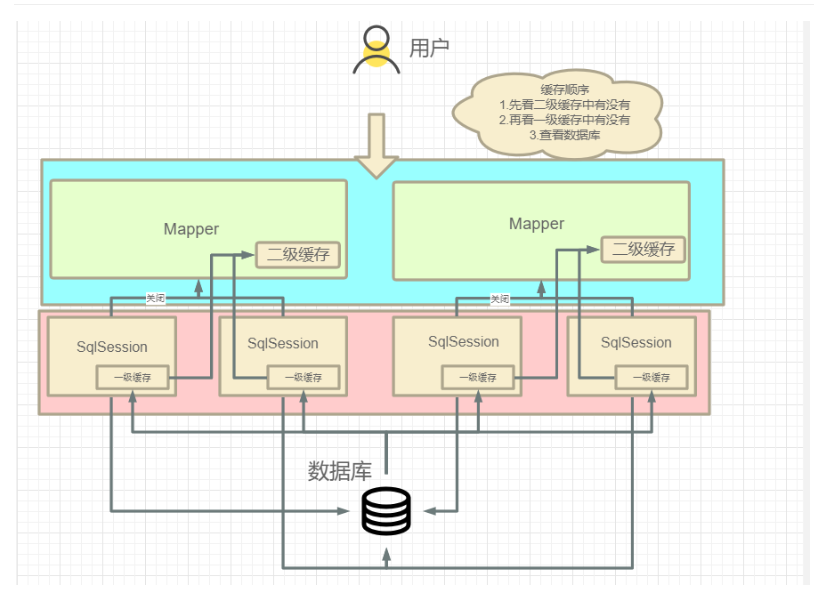嘿!Mybatis
简介
什么是Mybatis

- MyBatis 是一款优秀的持久层框架
- 它支持自定义 SQL、存储过程以及高级映射。
- MyBatis 免除了几乎所有的 JDBC 代码以及设置参数和获取结果集的工作。
- MyBatis 可以通过简单的 XML 或注解来配置和映射原始类型、接口和 Java POJO(Plain Old Java Objects,普通老式 Java 对象)为数据库中的记录。
- MyBatis 本是apache的一个开源项目iBatis, 2010年这个项目由apache software foundation 迁移到了google code,并且改名为MyBatis 。
- 2013年11月迁移到Github。
如何获得Mybatis?
- Maven仓库
<!-- https://mvnrepository.com/artifact/org.mybatis/mybatis -->
<dependency>
<groupId>org.mybatis</groupId>
<artifactId>mybatis</artifactId>
<version>3.4.6</version>
</dependency>
持久化
数据持久化
- 持久化就是将程序的数据在持久状态和瞬时状态转化的过程
- 内存:断电即失
- 数据库(JDBC),io文件持久化。
- 生活:冷藏,罐头。
为什么需要持久化?
-
有一些对象,不能让他丢掉。
-
内存太贵了(外在原因)
持久层
Dao层,Service层,Controller层....
- 完成持久层工作的代码块
- 层界限十分明显
为什么需要Mybatis?
- 帮助程序员将数据存入到数据库中。
- 方便
- 传统的JDBC代码太复杂了。简化。框架。自动化。
- 不用Mybatis也可以。更容易上手。技术没有高低之分,只有使用这项技术的人有高低之分
- 优点:
- 简单易学
- 灵活
- 降低sql与程序代码的耦合,提高了可维护性。
- 提供映射标签,支持对象与数据库的orm字段关系映射
- 提供对象关系映射标签,支持对象关系组建维护
- 提供xml标签,支持编写动态sql。
最重要的一点:使用的人多!
第一个Mybatis程序
思路:搭建环境-->导入Mybatis-->编写代码-->测试!
搭建环境
搭建数据库
CREATE DATABASE `mybatis`;
USE `mybatis`;
CREATE TABLE `user`(
`id`INT(20) NOT NULL,
`name`VARCHAR(30) DEFAULT NULL,
`pwd`VARCHAR(30) DEFAULT NULL,
PRIMARY KEY(`id`)
)ENGINE=INNODB DEFAULT CHARSET=utf8;
INSERT INTO `user` (`id`,`name`,`pwd`)VALUES
(1,'魏延','123456'),
(2,'马超','232315'),
(3,'赵云','123216');
新建项目
1.新建一个普通的maven项目
2.删除src目录
3.导入maven依赖
<!--导入依赖-->
<dependencies>
<!--mysql驱动-->
<dependency>
<groupId>mysql</groupId>
<artifactId>mysql-connector-java</artifactId>
<version>5.1.47</version>
</dependency>
<!--mybatis-->
<!-- https://mvnrepository.com/artifact/org.mybatis/mybatis -->
<dependency>
<groupId>org.mybatis</groupId>
<artifactId>mybatis</artifactId>
<version>3.4.6</version>
</dependency>
<!--junit-->
<dependency>
<groupId>junit</groupId>
<artifactId>junit</artifactId>
<version>4.11</version>
</dependency>
</dependencies>
创建一个模块
- 编写mybatis的核心配置文件
<?xml version="1.0" encoding="UTF-8" ?>
<!DOCTYPE configuration
PUBLIC "-//mybatis.org//DTD Config 3.0//EN"
"http://mybatis.org/dtd/mybatis-3-config.dtd">
<!--configuration核心配置文件-->
<configuration>
<!--环境-->
<environments default="development">
<environment id="development">
<!--事务管理-->
<transactionManager type="JDBC"/>
<dataSource type="POOLED">
<property name="driver" value="com.mysql.jdbc.Driver"/>
<property name="url" value="jdbc:mysql://localhost:3306/mybatis?useSSL=true&userUnicode=true&characterEncoding=UTF-8"/>
<property name="username" value="root"/>
<property name="password" value="root"/>
</dataSource>
</environment>
</environments>
<!--每一个Mapper.xml都需要在Mybatis核心配置文件中注册!-->
<mappers>
<mapper resource="com/wow/dao/UserMapper.xml"/>
</mappers>
</configuration>
- 编写mybatis的工具类
public class MybatisUtils {
private static SqlSessionFactory sqlSessionFactory;
static{
try {
//使用Mybatis第一步:获取SqlSessionFactory对象
String resource = "mybatis-config.xml";
InputStream inputStream = Resources.getResourceAsStream(resource);
SqlSessionFactory sqlSessionFactory = new SqlSessionFactoryBuilder().build(inputStream);
} catch (IOException e) {
e.printStackTrace();
}
}
/*
* 既然有了 SqlSessionFactory,顾名思义。
* 我们可以从中获得 SqlSession 的实例。SqlSession 提供了在数据库执行 SQL 命令所需的所有方法。
* 你可以通过 SqlSession 实例来直接执行已映射的 SQL 语句。
* */
public static SqlSession getSqlSession(){
return sqlSessionFactory.openSession(); //return 中可以传参数true 即设置为自动提交事务 也可以不设置 后面会提到
}
}
编写代码
- 实体类
//实体类
public class User {
private int id;
private String name;
private String pwd;
public User() {
}
public User(int id, String name, String pwd) {
this.id = id;
this.name = name;
this.pwd = pwd;
}
public int getId() {
return id;
}
public void setId(int id) {
this.id = id;
}
public String getName() {
return name;
}
public void setName(String name) {
this.name = name;
}
public String getPwd() {
return pwd;
}
public void setPwd(String pwd) {
this.pwd = pwd;
}
@Override
public String toString() {
return "User{" +
"id=" + id +
", name='" + name + '\'' +
", pwd='" + pwd + '\'' +
'}';
}
}
- Dao接口
public interface UserDao {
List<User> getUserList();
}
- 接口实现类由原来的UserDaoImpl转变为一个Mapper配置文件.
<?xml version="1.0" encoding="UTF-8" ?>
<!DOCTYPE mapper
PUBLIC "-//mybatis.org//DTD Mapper 3.0//EN"
"http://mybatis.org/dtd/mybatis-3-mapper.dtd">
<!--namespace=绑定一个对应的Dao/Mapper接口-->
<mapper namespace="com.wow.dao.UserDao">
<!--select查询语句-->
<select id="getUserList" resultType="com.wow.pojo.User">
select * from user
</select>
</mapper>
测试
注意点(可能会报错):

MapperRegistry是什么?
核心配置文件中注册mappers
- junit测试
public class UserDaoTest {
@Test
public void Test1(){
//第一步:获得sqlSession对象
SqlSession sqlSession = MybatisUtils.getSqlSession();
//方式一:getMapper
UserDao userDao = sqlSession.getMapper(UserDao.class);
List<User> userList = userDao.getUserList();
for (User user : userList) {
System.out.println(user);
}
//关闭sqlSession
sqlSession.close();
}
}
记录两个坑:第一个异常:


第二个异常:

因为IDEA的Maven是不会编译src的java目录的xml文件,所以在Mybatis的配置文件中找不到xml文件!
我的项目文件目录: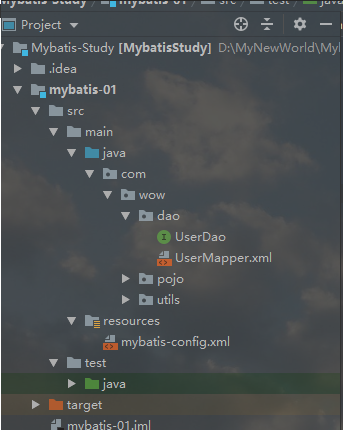
如果建立的是普通的java项目src下的xml文件是可以读到的: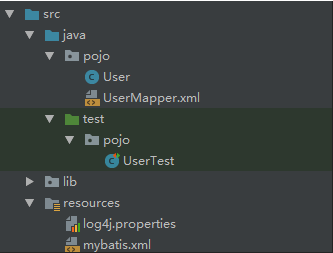
解决方法:在pom.xml文件中添加就应该解决了
<build>
<resources>
<resource>
<directory>src/main/java</directory>
<includes>
<include>**/*.xml</include>
</includes>
</resource>
</resources>
</build>

CRUD
namespace
namespace中的包名要和Dao/mapper接口的包名一致!
select
选择,查询语句:
- id:就是对应的namespace中的方法名;
- resultType:SQL语句执行的返回值;
- parameterType:参数类型;
1.编写接口
public interface UserMapper {
//查询全部用户
List<User> getUserList();
//根据id查询用户
User getUserById(Integer id);
}
2.编写对应的mapper中的sql语句
下面sql语句中mybatis.user是在IDEA中已经连接上数据库了
没有连接的话需要写原生的SQL语句
<?xml version="1.0" encoding="UTF-8" ?>
<!DOCTYPE mapper
PUBLIC "-//mybatis.org//DTD Mapper 3.0//EN"
"http://mybatis.org/dtd/mybatis-3-mapper.dtd">
<!--namespace=绑定一个对应的Dao/Mapper接口-->
<mapper namespace="com.wow.dao.UserMapper">
<!--select查询语句-->
<select id="getUserList" resultType="com.wow.pojo.User" >
select * from mybatis.user
</select>
<select id="getUserById" parameterType="int" resultType="com.wow.pojo.User">
select * from mybatis.user where id = #{id}
</select>
</mapper>
3.测试
//第一步:获得sqlSession对象
SqlSession sqlSession = MybatisUtils.getSqlSession();
//方式一:getMapper 查询所有用户信息
UserMapper userDao = sqlSession.getMapper(UserMapper.class);
List<User> userList = userDao.getUserList();
for (User user : userList) {
System.out.println(user);
}
//根据用户id查询
User user = mapper.getUserById(1);
System.out.println(user);
//关闭sqlSession
sqlSession.close();
Insert
Xml:
<insert id="addUser" parameterType="com.wow.pojo.User" >
insert into mybatis.user (id, name, pwd) values(#{id},#{name},#{pwd})
</insert>
测试:
SqlSession sqlSession = MybatisUtils.getSqlSession();
UserMapper mapper = sqlSession.getMapper(UserMapper.class);
int i = mapper.addUser(new User(4, "吕布", "1231325"));
if (i > 0) {
System.out.println("插入成功!");
}
sqlSession.commit();
sqlSession.close();
update
<update id="updateUser" parameterType="com.wow.pojo.User">
update mybatis.user set name= #{name},pwd=#{pwd} where id = #{id}
</update>
Delete
<delete id="deleteUser" parameterType="int">
delete from mybatis.user where id = #{id}
</delete>
注意点:
- 增删改需要提交事务!
分析错误
- 标签不要匹配错
- resource绑定mapper,需要使用路径:xxx/xxx/xxx/xxx.xml
- 程序匹配文件必须符合规范!(如果有异常的话从后往前读)
- NullPointerException,没有注册到资源!
- 输出的xml文件中存在中文乱码问题!
- maven资源没有导出!
万能的Map
假设,我们的实体类,或者数据库中的表,字段或参数过多,我们应当考虑使用Map!
//万能的Map
int addUser2(Map<String,Object> map);
<insert id="addUser2" parameterType="map" >
insert into mybatis.user (id, pwd) values(#{userid},#{password})
</insert>
@Test
public void test6() {
SqlSession sqlSession = MybatisUtils.getSqlSession();
UserMapper mapper = sqlSession.getMapper(UserMapper.class);
Map<String, Object> map = new HashMap<String, Object>();
map.put("userid",8);
map.put("password","123547");
mapper.addUser2(map);
sqlSession.commit();
sqlSession.close();
}
Map传递参数,直接在sql中取出key即可!【parameterType="map" 】
对象传递参数,直接在sql中取对象的属性即可!【parameterType="Object" 】
只有一个基本类型参数的情况下,可以直接在sql中取到!
多个参数用map,或者注解!
模糊查询
模糊查询怎么写?
1.Java代码执行的时候,传递通配符 % %
List<User> userList = userDao.getUserLike("%布%");
//查询结果
/*
User{id=1, name='吕布', pwd='203457'}
User{id=5, name='布小蛮', pwd='667841'}
*/
2.在sql拼接中使用通配符!
<select id="getUserLike" resultType="com.wow.pojo.User">
select * from mybatis.user where name like "%"#{value}"%"
</select>
List<User> userList = userDao.getUserLike("布");
/*
查询结果
User{id=1, name='吕布', pwd='203457'}
User{id=5, name='布小蛮', pwd='667841'}
*/
配置解析
核心配置文件
- mybatis-config.xml
- MyBatis 的配置文件包含了会深深影响 MyBatis 行为的设置和属性信息。
- configuration(配置)
- properties(属性)
- settings(设置)
- typeAliases(类型别名)
- typeHandlers(类型处理器)
- objectFactory(对象工厂)
- plugins(插件)
- environments(环境配置)
- environment(环境变量)
- transactionManager(事务管理器)
- dataSource(数据源)
- environment(环境变量)
- databaseIdProvider(数据库厂商标识)
- mappers(映射器)
环境配置(environments)
MyBatis 可以配置成适应多种环境
不过要记住:尽管可以配置多个环境,但每个 SqlSessionFactory 实例只能选择一种环境。
学会使用配置多套运行环境!
Mybatis默认的事务管理器就是JDBC,连接池:POOLED
属性(properties)
我们可以通过properties属性来实现引用配置文件
这些属性可以在外部进行配置,并可以进行动态替换。你既可以在典型的 Java 属性文件中配置这些属性,也可以在 properties 元素的子元素中设置。[db.properties]

编写一个配置文件
db.properties
db.driver=com.mysql.jdbc.Driver
db.url=jdbc:mysql://localhost:3306/mybatis?useSSL=true&userUnicode=true&characterEncoding=UTF-8
db.user=root
db.password=root
在核心配置文件中引入

- 可以直接引入外部文件
- 可以在其中增加一些属性配置
- 如果两个文件有相同字段,会优先使用外部配置文件!
类型别名(typeAliases)
- 类型别名可为 Java 类型设置一个缩写名字。
- 它仅用于 XML 配置,意在降低冗余的全限定类名书写。
<!--可以给实体类起别名-->
<typeAliases>
<typeAlias type="com.wow.pojo.User" alias="User"/>
</typeAliases>

也可以指定一个包名,MyBatis 会在包名下面搜索需要的 Java Bean,比如:
扫描实体类的包,它的默认别名就为这个类的类名,首字母小写!
<typeAliases>
<package name="com.wow.pojo"/>
</typeAliases>
在实体类比较少的情况下,使用第一种。
如果实体类比较多,建议第二种。
第一种可以DIY(自定义)别名,第二种不能DIY,如果非要改,需要在实体类上增加注解:
@Alias("user")
public class User {
...
}
设置
这是Mybatis中极为重要的调整设置,它们会改变MyBatis的运行行为。

其他配置
- typeHandlers(类型处理器)
- objectFactory(对象工厂)
- plugins(插件)
- mybatis-generator-core
- mybatis-plus
- 通用mapper
映射器(mappers)
MapperRegistry:注册绑定我们的Mapper文件:
方式一:
<!--每一个Mapper.xml都需要在Mybatis核心配置文件中注册!-->
<mappers>
<mapper resource="com/wow/dao/UserMapper.xml"/>
</mappers>
方式二:使用class文件绑定注册
<!--每一个Mapper.xml都需要在Mybatis核心配置文件中注册!-->
<mappers>
<mapper class="com.wow.dao.UserMapper"/>
</mappers>
注意点:
- 接口和它的Mapper配置文件必须同名!
- 接口和它的Mapper配置文件必须在同一个包下!
方式三:使用扫描包进行注入绑定
<!--每一个Mapper.xml都需要在Mybatis核心配置文件中注册!-->
<mappers>
<package name="com.wow.dao"/>
</mappers>
注意点:
- 接口和它的Mapper配置文件必须同名!
- 接口和它的Mapper配置文件必须在同一个包下!
- 保证UserMapper接口和UserMapper.xm改为一致,并在同一包下!
作用域(Scope)和生命周期
生命周期类别是至关重要的,因为错误的使用会导致非常严重的并发问题。
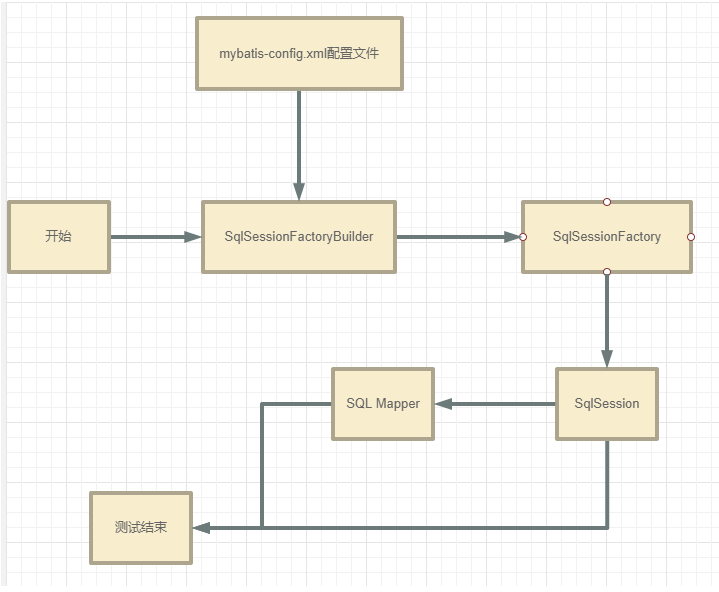
SqlSessionFactoryBuilder:
- 一旦创建了 SqlSessionFactory,就不再需要它了。
- 局部变量
SqlSessionFactory:
- 说白了就是可以想象为:数据库连接池
- SqlSessionFactory 一旦被创建就应该在应用的运行期间一直存在,没有任何理由丢弃它或重新创建另一个实例。
- 因此 SqlSessionFactory 的最佳作用域是应用作用域。
- 最简单的就是使用单例模式或者静态单例模式。
SqlSession:
- 连接到连接池的一个请求!
- SqlSession 的实例不是线程安全的,因此是不能被共享的,所以它的最佳的作用域是请求或方法作用域。
- 用完之后需要赶紧关闭,否则资源被占用!
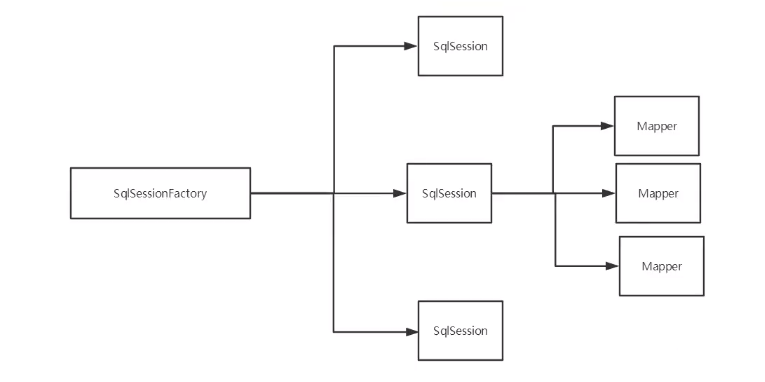
这里的每一个Mapper,就代表了一个具体的业务!
解决属性名和字段名不一致的问题
问题
数据库中的字段:

新建一个项目,拷贝之前的,情况测试实体类字段不一致的:
//实体类
public class User {
private int id;
private String name;
private String password;
}
测试出现问题:

select * from mybatis.user where id = #{id}
//类型处理器
select id,name,pwd from mybatis.user where id = #{id}
解决方案:
- 起别名
<select id="getUserById" parameterType="int" resultType="wow.pojo.User">
select id,name,pwd as password from mybatis.user where id = #{id}
</select>
resultMap
结果集映射:
id name pwd
id name password
<!--结果集映射-->
<resultMap id="UserMap" type="User">
<!--column:数据库中的字段,property:实体类的属性-->
<result column="id" property="id"/>
<result column="name" property="name"/>
<result column="pwd" property="password"/>
</resultMap>
<select id="getUserById" resultMap="UserMap">
select * from mybatis.user where id = #{id}
</select>
- ResultMap 元素是 MyBatis 中最重要最强大的元素
- ResultMap 的设计思想是,对简单的语句做到零配置,对于复杂一点的语句,只需要描述语句之间的关系就行了。
- 你不需要显式配置
ResultMap,这就是ResultMap的优秀之处——你完全可以不用显式地配置它们。 - 如果这个世界总是这么简单就好了。
日志
日志工厂
如果一个数据库操作,出现了异常,我们需要排错。日志就是我们的好帮手!
曾经:sout,debug
现在:日志工厂来实现

- SLF4J
- LOG4J 【掌握使用】
- LOG4J2
- JDK_LOGGING
- COMMONS_LOGGING
- STDOUT_LOGGING 【掌握使用】
- NO_LOGGING
在mybatis中具体使用哪一个日志实现,在设置中设定!
STDOUT_LOGGING 标准日志输出
在mybatis核心配置文件中,配置我们的日志!
<settings>
<setting name="logImpl" value="STDOUT_LOGGING"/>
</settings>

LOG4J
什么是log4j?
- Log4j是Apache的一个开源项目,通过使用Log4j,我们可以控制日志信息输送的目的地是控制台、文件、GUI组件.
- 我们也可以控制每一条日志的输出格式;
- 通过定义每一条日志信息的级别,我们能够更加细致地控制日志的生成过程。
- 最令人感兴趣的就是,这些可以通过一个配置文件来灵活地进行配置,而不需要修改应用的代码。
1.先导入log4j的包
<!-- https://mvnrepository.com/artifact/log4j/log4j -->
<dependency>
<groupId>log4j</groupId>
<artifactId>log4j</artifactId>
<version>1.2.17</version>
</dependency>
2.log4j.properties
#将等级为DEBUG的日志信息输出到console和file这个两个目的地,console和file的定义在下面的代码
log4j.rootLogger=DEBUG,console,file
#log4j.ignoreTCL=true
#控制台输出的相关设置
log4j.appender.console = org.apache.log4j.ConsoleAppender
log4j.appender.console.Target = System.out
log4j.appender.console.Threshold = DEBUG
log4j.appender.console.layout = org.apache.log4j.PatternLayout
log4j.appender.console.layout.ConversionPattern = [%c]-%m%n
#文件输出的相关设置
log4j.appender.file = org.apache.log4j.RollingCalendar
log4j.appender.file.File = ./log/kuang.log
log4j.appender.file.MaxFilesSize = 10mb
log4j.appender.file.Threshold = DEBUG
log4j.appender.file.layout=org.apache.log4j.PatternLayout
log4j.appender.file.layout.ConversionPattern=[%p][%d{yy-MM-dd}][%c]%m%n
#日志输出级别
log4j.logger.org.mybatis=DEBUG
log4j.logger.java.sql = DEBUG
log4j.logger.java.sql.Statement=DEBUG
log4j.logger.java.sql.ResultSet = DEBUG
log4j.logger.java.sql.PreparedStatement=DEBUG
3.配置log4j为日志的实现
<settings>
<setting name="logImpl" value="LOG4J"/>
</settings>
4.Log4j的使用,测试运行
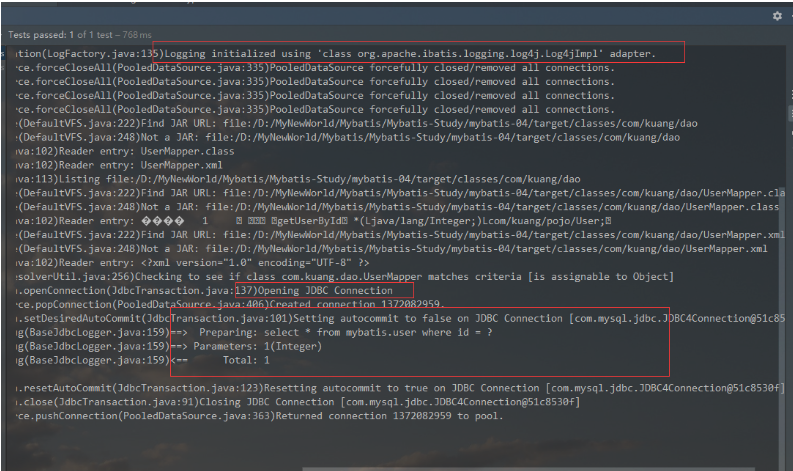
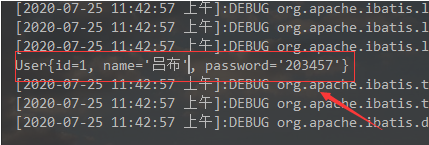
简单使用
1.在要使用Log4j的类中,导入包import org.apache.log4j.Logger;
2.日志对象,参数为当前类class
static Logger logger = Logger.getLogger(UserDaoTest.class);
3.日志级别
@Test
public void testLog4j(){
logger.info("info:进入了testLog4j");
logger.debug("debug:进入了testLog4j");
logger.error("error:进入了testLog4j");
}
分页
为什么要分页?
- 减少数据的处理量
使用Limit分页
语法:SELECT * from 表名 limit startIndex,pageSize;
select * from user limit 3; #[0,n]
使用mybatis实现分页,核心SQL
1.接口
//分页
List<User> getUserByLimit(Map<String,Integer> map);
2.Mapper.xml
<!--结果集映射-->
<resultMap id="UserMap" type="com.kuang.pojo.User">
<!--column=数据库中的字段,property=实体类的属性-->
<!--<result column="id" property="id"/>-->
<!--<result column="name" property="name"/>-->
<result column="pwd" property="password"/>
</resultMap>
<select id="getUserByLimit" parameterType="map" resultMap="UserMap">
select * from mybatis.user limit #{startIndex},#{pageSize};
</select>
3.Demo
@Test
public void test2(){
SqlSession sqlSession = MybatisUtils.getSqlSession();
UserMapper mapper = sqlSession.getMapper(UserMapper.class);
Map<String, Integer> map = new HashMap<String, Integer>();
map.put("startIndex",1);
map.put("pageSize",2);
List<User> list = mapper.getUserByLimit(map);
for (User user : list) {
System.out.println(user);
}
sqlSession.close();
}
RowBounds分页
不在使用SQL实现分页
1.接口
//分页2
List<User> getUserByRowBounds();
2.Mapper.xml
<!--分页2-->
<select id="getUserByRowBounds" resultMap="UserMap">
select * from mybatis.user
</select>
3.demo
@Test
public void test3(){
SqlSession sqlSession = MybatisUtils.getSqlSession();
//RowBounds实现
RowBounds rowBounds = new RowBounds(1, 3);
//通过Java代码层面实现分页
List<User> userList = sqlSession.selectList("com.kuang.dao.UserMapper.getUserByRowBounds", null, rowBounds);
for (User user : userList) {
System.out.println(user);
}
sqlSession.close();
}
分页插件
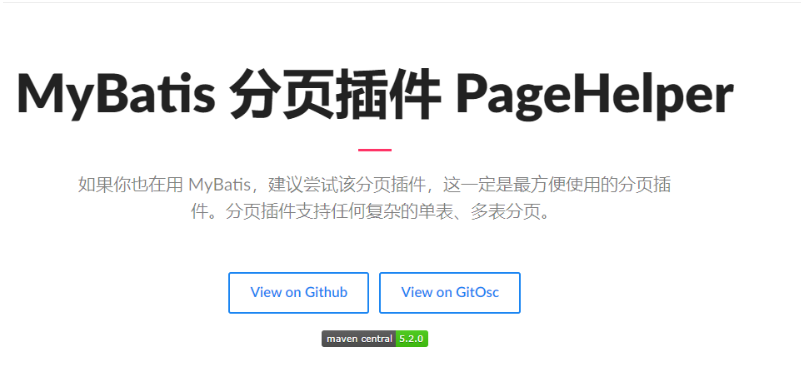
使用注解开发
面向接口编程
- 在之前都学过面向对象编程,也学习过接口,但在真正的开发中,很多时候我们会选择面向接口编程
- 根本原因:解耦,可拓展,提高复用,分层开发中,上层不用管具体实现,大家都遵守共同的标准,使得开发变得容易,规范性更好。
- 在一个面向对象的系统中,系统的各种功能是由许许多多的不同对象协作完成的。在这种情况下,各个对象内部是如何实现自己的,对系统设计人员来讲就不那么重要了。
- 而各个对象之间的协作关系则成为系统设计的关键。小到不同类之间的通信,大到各模块之间的交互,在系统设计之初都是要着重考虑的,这也是系统设计的主要工作。面向接口 编程就是指按照这种思想来编程。
关于接口的理解
- 接口更深层次的理解,应是定义(规范,约束)与实现(名实分离的原则)的分离。
- 接口的本身反映了系统设计人员对系统的抽象理解。
- 接口应有两种:
- 第一类是对一个个体的抽象,它可对应一个抽象体(abstract class)。
- 第二类是对一个个体某一方面的抽象,即形成一个抽象面(interface)。
- 一个个体有可能有多个抽象面,抽象体和抽象面是有区别的。
三个面向区别
- 面向对象是指,我们考虑问题时,以对象为单位,考虑它的属性及方法。
- 面向过程是指,我们考虑问题时,以一个具体的流程(事务过程)为单位,考虑它的实现。
- 接口设计与非接口设计是针对复用技术而言的,与面向对象(过程)不是一个问题,更多的体现就是对系统整体的架构
使用注解开发
1.注解在接口上实现
public interface UserMapper {
@Select("select * from user")
public List<User> getUsers();
}
2.需要在核心配置文件中绑定接口!
<mappers>
<!--<mapper resource="com/wow/dao/UserMapper.xml"/>-->
<mapper class="kuang.dao.UserMapper"/>
<!--<package name="com.kuang.dao"/>-->
</mappers>
3.demo
@Test
public void test(){
SqlSession sqlSession = MybatisUtils.getSqlSession();
UserMapper mapper = sqlSession.getMapper(UserMapper.class);
List<User> users = mapper.getUsers();
for (User user : users) {
System.out.println(user);
}
sqlSession.close();
}
本质:反射机制实现
底层:动态代理!
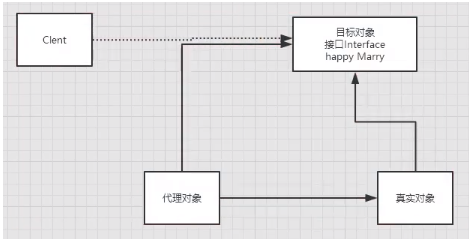
Mybatis详细的执行流程!
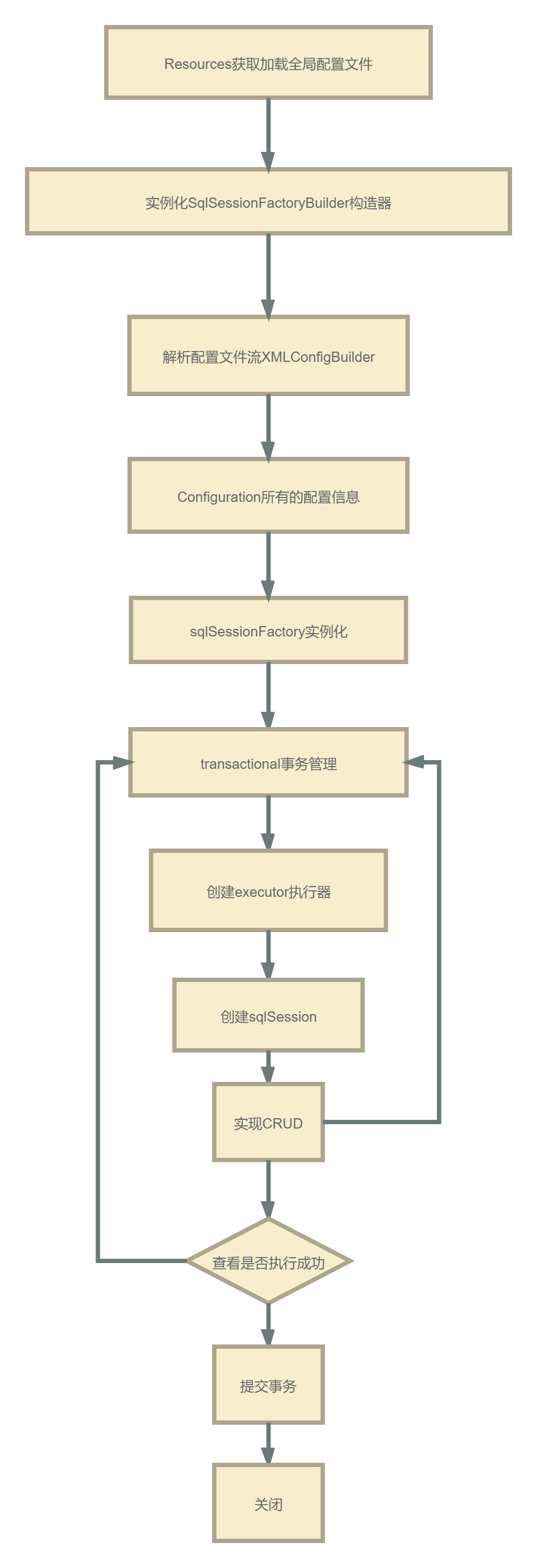
CRUD
可以直接在工具类创建的时候实现自动提交事务!
public static SqlSession getSqlSession(){
return sqlSessionFactory.openSession(true);
}
编写接口,增加注解
public interface UserMapper {
@Select("select * from user")
public List<User> getUsers();
// 方法存在多个参数,所有的参数前面必须加上@Param("id")注解
@Select("select * from user where id = #{id}")
User getUserByID(@Param("id") int id);
@Insert("insert into user(id,name,pwd) values (#{id},#{name},#{password})")
int addUser(User user);
@Update("update user set name=#{name},pwd=#{password} where id = #{id}")
int updateUser(User user);
@Delete("delete from user where id = #{uid}")
int deleteUser(@Param("uid") int id);
}
测试的话:
【注意:必须要将接口注册绑定到核心配置文件中!】
关于@Param()注解
- 基本类型的参数或者String类型,需要加上
- 引用类型不需要加
- 如果只有一个基本类型的话,可以忽略,但是建议都加上!
- 在SQL中引用的就是我们这里的@Param()中设定的属性名!
关于 #{} 与 ${}的区别
- 用来传入参数,sql在解析的时候会加上" ",当成字符串来解析 ,如这里 u_id = "uid"。
- #{}能够很大程度上防止sql注入。
- ${}方式无法防止sql注入;
多对一处理
多对一(例):
- 多个学生,对应一个老师
- 对于学生而言,关联..多个学生,关联一个老师【多对一】
- 对于老师而言,集合,一个老师,有很多学生【一对多】

SQL:
CREATE TABLE `teacher`(
`id`INT(10) NOT NULL,
`name`VARCHAR(30)DEFAULT NULL,
PRIMARY KEY(`id`)
)ENGINE=INNODB DEFAULT CHARSET = utf8
INSERT INTO teacher(`id`,`name`)VALUES(1,'苏老师');
CREATE TABLE `student`(
`id` INT(10) NOT NULL,
`name`VARCHAR(30)DEFAULT NULL,
`tid` INT(10)DEFAULT NULL,
PRIMARY KEY(`id`),
KEY `fktid`(`tid`),
CONSTRAINT `fktid` FOREIGN KEY(`tid`)REFERENCES `teacher`(`id`)
)ENGINE=INNODB DEFAULT CHARSET=utf8
INSERT INTO `student`(`id`,`name`,`tid`)VALUES('1','张三','1');
INSERT INTO `student`(`id`,`name`,`tid`)VALUES('2','李四','1');
INSERT INTO `student`(`id`,`name`,`tid`)VALUES('3','王五','1');
INSERT INTO `student`(`id`,`name`,`tid`)VALUES('4','赵六','1');
INSERT INTO `student`(`id`,`name`,`tid`)VALUES('5','郑七','1');
测试环境搭建
- 新建实体类Teacher,Student
public class Student {
private int id;
private String name;
private Teacher teacher ;
/*
get,set,toString...
*/
}
public class Teacher {
private int id;
private String name;
}
/*
get,set,toString..
*/
- 新建相对应的Mapper接口
- 新建Mapper.xml文件

- 在核心配置文件中绑定注册我们的Mapper接口或者文件!
- 测试
按照查询嵌套处理
<mapper namespace="kuang.dao.StudentMapper">
<!--
思路:
1.查询所有的学生信息
2.根据查询出来的学生的tid,寻找对应的老师! 子查询
-->
<select id="getStudent" resultMap="StudentTeacher">
select * from student
</select>
<resultMap id="StudentTeacher" type="Student">
<result property="id" column="id"/>
<result property="name" column="name"/>
<!--复杂的属性,需要单独处理,对象:association 集合:collection-->
<association property="teacher" column="tid" javaType="Teacher" select="getTeacher"/>
</resultMap>
<select id="getTeacher" resultType="Teacher">
select * from teacher where id = #{id}
</select>
</mapper>
按照结果嵌套处理
<!--按照结果嵌套处理-->
<select id="getStudent2" resultMap="StudentTeacher2">
select s.id sid ,s.name sname ,t.name tname
from student s, teacher t
where s.tid = t.id
</select>
<resultMap id="StudentTeacher2" type="Student">
<result property="id" column="sid"/>
<result property="name" column="sname"/>
<association property="teacher" javaType="Teacher">
<result property="name" column="tname"/>
</association>
</resultMap>
一对多
例:一个老师对应多个学生
对于老师而言,就是一对多的关系
环境搭建
实体类
public class Student {
private int id;
private String name;
private int tid;
/*
set,get,toString..
*/
}
public class Teacher {
private int id;
private String name;
//一个老师有多个学生
private List<Student> students;
/*
set,get,toString...
*/
}
接口
public interface TeacherMapper {
//获取指定老师下的所有学生及老师信息
Teacher getTeacher(@Param("tid") int id);
Teacher getTeacher2(@Param("tid") int id);
}
按照结果嵌套处理
<mapper namespace="kuang.dao.TeacherMapper">
<!--按结果嵌套查询-->
<select id="getTeacher" resultMap="StudentTeacher">
select s.id sid,s.name sname,t.name tname,t.id tid
from student s ,teacher t
where s.tid = t.id and t.id = #{tid}
</select>
<resultMap id="StudentTeacher" type="Teacher">
<result property="id" column="tid"/>
<result property="name" column="tname"/>
<!--复杂的属性,需要单独处理,对象:association 集合:collection
javaType="" 指定属性的类型!
集合中的泛型信息,我们使用ofType获取
-->
<collection property="students" ofType="Student">
<result property="id" column="sid"/>
<result property="name" column="sname"/>
<result property="tid" column="tid"/>
</collection>
</resultMap>
</mapper>
按照查询嵌套处理
<mapper namespace="kuang.dao.TeacherMapper">
<!--按照嵌套查询-->
<select id="getTeacher2" resultMap="StudentTeacher2">
select * from teacher where id = #{tid}
</select>
<resultMap id="StudentTeacher2" type="Teacher">
<collection property="students" javaType="ArrayList" ofType="Student" select="getStudentByTeacherId" column="id"/>
</resultMap>
<select id="getStudentByTeacherId" resultType="Student">
select * from student where tid = #{tid}
</select>
</mapper>
小结
1.关联 - association 【多对一】
2.集合 - collection【一对多】
3.javaType & ofType
1.javaType 用来指定实体类中属性的类型
2.ofType 用来指定映射到List或者集合中的pojo类型,泛型中的约束类型!
注意点:
- 保证SQL的可读性,尽量保证通俗易懂
- 注意一对多和多对一中,属性名和字段的问题!
- 如果问题不好排查错误,可以使用日志 ,建议使用Log4j
慢SQL的问题
面试高频
- Mysql引擎
- InnoDB底层原理
- 索引
- 索引优化
动态SQL
什么是动态SQL:动态SQL就是指根据不同的条件生成不同的SQL语句
利用动态 SQL,可以彻底摆脱这种痛苦。
如果你之前用过 JSTL 或任何基于类 XML 语言的文本处理器,你对动态 SQL 元素可能会感觉似曾相识。在 MyBatis 之前的版本中,需要花时间了解大量的元素。借助功能强大的基于 OGNL 的表达式,MyBatis 3 替换了之前的大部分元素,大大精简了元素种类,现在要学习的元素种类比原来的一半还要少。
if
choose (when, otherwise)
trim (where, set)
foreach
搭建环境
SQL语句:
CREATE TABLE `blog`(
`id` VARCHAR(50) NOT NULL COMMENT '博客id',
`title` VARCHAR(100) NOT NULL COMMENT '博客标题',
`author` VARCHAR(30) NOT NULL COMMENT '博客作者',
`create_time` DATETIME NOT NULL COMMENT '创建时间',
`views` INT(30) NOT NULL COMMENT '浏览量'
)ENGINE=INNODB DEFAULT CHARSET=utf8
创建一个基础工程
1.导包
2.编写配置文件
3.编写实体类
public class Blog {
private int id;
private String title;
private String author;
private Date createTime;
private int views;
/**
get , set , toString...
*/
}
4.编写实体类对应Mapper接口和Mapper.xml文件
IF
<mapper namespace="com.kuang.dao.BlogMapper">
<insert id="addBlog" parameterType="blog">
insert into blog values (#{id},#{title},#{author},#{createTime},#{views})
</insert>
<select id="queryBlogIf" parameterType="map" resultType="blog">
select * from blog where 1 = 1
<if test="title != null">
and title = #{title}
</if>
<if test="author != null">
and author = #{author}
</if>
</select>
</mapper>
choose (when, otherwise)
<select id="queryBlogChoose" parameterType="map" resultType="blog">
select * from blog
<where>
<choose>
<when test="title != null">
title = #{title}
</when>
<when test="author != null">
and author = #{author}
</when>
<otherwise>
and views = #{views}
</otherwise>
</choose>
</where>
</select>
trim (where, set)
<select id="queryBlogIf" parameterType="map" resultType="blog">
select * from blog
<where>
<if test="title != null">
and title = #{title}
</if>
<if test="author != null">
and author = #{author}
</if>
</where>
</select>
<update id="updateBlog" parameterType="map">
update blog
<set>
<if test="title != null">
title = #{title},
</if>
<if test="author != null">
author = #{author}
</if>
</set>
where id = #{id}
</update>
所谓的动态SQL,本质还是SQL语句,只是我们可以再SQL层面,去执行一个逻辑代码
SQL片段
有的时候,我们可以会将一些功能的部分抽取出来,方便复用!
1.使用SQL标签抽取公共部分
<sql id="ifif">
<if test="title != null">
and title = #{title}
</if>
<if test="author != null">
and author = #{author}
</if>
</sql>
2.在需要使用的地方使用include标签引用即可
<select id="queryBlogIf" parameterType="map" resultType="blog">
select * from blog
<where>
<include refid="ifif"></include>
</where>
</select>
注意事项:
- 最好基于单表来定义SQL片段!
- 不要存在where标签
Foreach
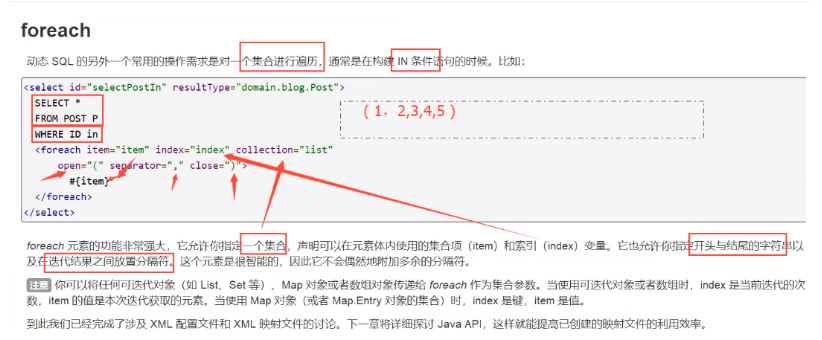

测试:定义接口
//查询1、2、3号记录的博客
List<Blog> queryBlogForeach(Map map);
Mapper
<!--
select * from blog where 1 = 1 and (id=1 or id=2 or id=3)
现在往这个接口中传一个map,这个map中可以存在一个集合
-->
<select id="queryBlogForeach" parameterType="map" resultType="blog">
select * from blog
<where>
<foreach collection="ids" item="id" open="(" close=")" separator="or">
id = #{id}
</foreach>
</where>
</select>
测试:
@Test
public void test3(){
SqlSession sqlSession = MybatisUtils.getSqlSession();
BlogMapper mapper = sqlSession.getMapper(BlogMapper.class);
ArrayList list = new ArrayList();
list.add(1);
list.add(2);
list.add(3);
Map map = new HashMap();
map.put("ids",list);
List<Blog> blogs = mapper.queryBlogForeach(map);
for (Blog blog : blogs) {
System.out.println(blog);
}
sqlSession.close();
}
结果:

动态SQL就是在拼接SQL语句,我们只要保证SQL的正确性,按照SQL的格式,去排列组合就可以了
建议:
- 现在MySQL中写出完整的SQL,在对应的去修改成为我们的动态sql实现通用即可!!
缓存
简介
1.什么是缓存[Cache]?
- 存在内存中的临时数据。
- 将用户经常查询的数据放在缓存(内存)中,用户去查询数据就不用从磁盘上(关系型数据库数据文件)中查询,从缓存中查询,从而提高查询效率,解决了高并发系统的性能问题。
2.为什么使用缓存?
- 减少和数据库的交互次数,减少系统开销,提高系统效率。
3.什么样的数据能使用缓存?
- 经常查询并且不经常改变的数据。
Mybatis缓存
- Mybatis包含一个非常强大的查询缓存特性,它可以非常方便地定制和配置缓存。缓存可以极大的提升查询效率。
- Mybatis系统中默认定义了二级缓存,一级缓存和二级缓存
- 默认情况下,只有一级缓存开启,(SqlSession级别的缓存,也称为本地缓存)。
- 二级缓存需要手动开启和配置,它是基于namespace级别的缓存。
- 为了提高扩展性,Mybatis定义了缓存接口Cache。我们可以通过实现Cache接口来定义二级缓存
一级缓存
- 一级缓存也叫本地缓存:
- 与数据库同一次会话期间查询到的数据会放在本地缓存中。
- 以后如果需要获取相同的数据,直接从缓存中拿,没必须在去查询数据库。
测试:
1.开启日志
2.测试在一个Session中查询两次相同记录
3.查看日志输出
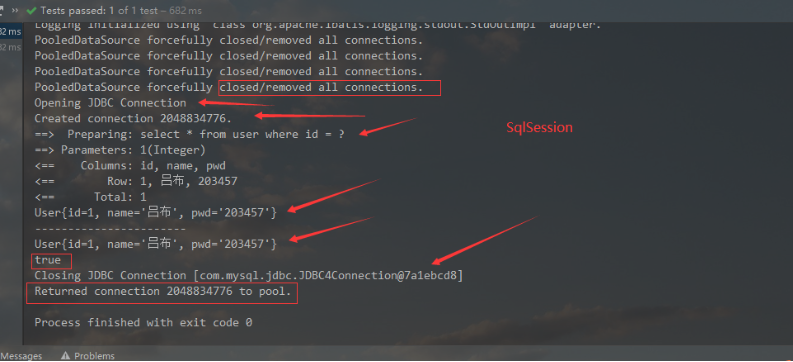
缓存失效的情况:
1.查询不同的东西
2.增删改操作,有可能会改变原来的数据,所以必定会刷新数据!
3.查询不同的Mapper.xml
4.手动清理缓存!

小结:一级缓存是默认开启的,只在一次SqlSession中有效,也就是拿到链接到关闭链接这个区间段!
一级缓存相当于一个map
二级缓存
- 二级缓存也叫全局缓存,一级缓存作用域太低了,所以诞生了二级缓存
- 基于namespace级别的缓存,一个名称空间,对应一个二级缓存。
- 工作机制
- 一个会话查询一条记数据,这个数据就会被放在当前会话的一级缓存中。
- 如果当前会话关闭了,这个会话对应的一级缓存就没了;但我我们想要的是,会话关闭了,一级缓存中的数据被保存到二级缓存中;
- 新的会话查询信息,就可以从二级缓存中获取内容;
- 不同的mapper查出的数据会放在自己对应的缓存(map)中;
步骤:
1.开启全局缓存
<settings>
<!--显示的开启全局缓存-->
<setting name="cacheEnabled" value="true"/>
</settings>
2.要使用二级缓存的Mapper中开启
<!--在当前Mapper.xml中使用二级缓存-->
<cache/>
也可以自定义参数
<!--在当前Mapper.xml中使用二级缓存-->
<cache eviction="FIFO"
flushInterval="60000"
size="512"
readOnly="true"
/>
3.测试:
可能出现的问题:如果在

Caused by: java.io.NotSerializableException: com.kuang.pojo.User
小结:
- 只要开启了二级缓存,在同一个Mapper下就会生效
- 所有的数据都会先放在一级缓存中;
- 只有当会话提交,或者关闭的时候,才会提交到二级缓存中;
缓存原理
